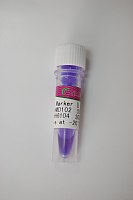Homology Cloning of cDNA or Genomic DNA
互联网
- Abstract
- Table of Contents
- Materials
- Literature Cited
Abstract
The principle of cloning utilizes hybridization of single?stranded DNA probes to denatured DNA fixed on membranes to detect the identical DNA molecules present in a large population of diverse DNAs. In homology or low?stringency cloning, hybridization of oligonucleotide, cDNA, or genomic DNA probes to denatured DNA from plasmid or bacteriophage libraries is carried out under low?stringency conditions that promote hybridization in the presence of sequence mismatch (i.e., mispaired nucleotides). The procedures used are identical to those for screening libraries at high stringency, with the exception that hybridization and washing conditions are altered to permit hybridization with mismatched sequence; salt concentration is increased and the hybridization and wash temperatures are decreased. This unit describes conditions that have been used to clone and identify novel genes and cDNA clones using low?stringency hybridization of known probes to membranes that contain libraries of bacterial or bacteriophage DNA.
Table of Contents
- Reagents and Solutions
- Commentary
- Literature Cited
Materials
Basic Protocol 1:
Materials
|
Figures
Videos
Literature Cited
| Literature Cited | |
| Albert, P.R., Zhou, Q.‐Y., VanTol, H.H.M., Bunzow, J., and Civelli, O. 1990. Cloning, functional expression, and mRNA tissue distribution of the rat 5‐HT1A receptor gene. J. Biol. Chem. 265:5825‐5832 | |
| Albert, P.R. 1992. Molecular biology of the 5‐HT1A receptor: Low‐stringency cloning and eukaryotic expression. J. Chem. Neuroanat. 5:283‐288. | |
| Bunzow, J.R., VanTol, H.H.M., Grandy, D., Albert, P., Salon, J., Christie, M., Machida, C., Neve, K.A., and Civelli, O. 1988. Cloning and expression of a rat dopamine‐D2 receptor cDNA. Nature 336:783‐787. | |
| Davis, L.G., Dibner, M.D., and Battey, J.F. 1986. Basic Methods in Molecular Biology. Elsevier, New York., N.Y. | |
| Kobilka, B.K., Frielle, T., Collins, S., Yang‐Feng, T., Kobilka, T.S., Francke, U., Lefkowitz, R.J., and Caron, M.G. 1987. An intronless gene encoding a potential member of the family of receptors coupled to guanine nucleotide regulatory proteins. Nature 329:75‐79. | |
| Libert, F., Parmentier, M., Lefort, A., Dinsart, C., Van Sande, J., Maenhaut, C., Simons, M.‐J., Dumont, J.E., and Vassart, G. 1989. Selective amplification and cloning of four new members of the G protein–coupled receptor family. Science 570:569‐572. | |
| Sambrook, J., Fritsch, E.F., and Maniatis, T. 1989. Molecular Cloning: A Laboratory Manual, 2nd ed. Cold Spring Harbor Laboratory, Cold Spring Harbor, N.Y. | |
| Shigemoto, R., Yokota, Y., Tsuchida, K., and Nakanishi, S. 1990. Cloning and expression of a neuromedin K receptor cDNA J.Biol. Chem. 265:623‐628. | |
| Yokota, Y., Sasai, Y., Tanaka, K., Fujiwara, T., Tsuchida, K., Shigemoto, R., Kakizuka, A., Ohkubo, H., and Nakanishi, S. 1989. Molecular characterization of a functional cDNA for rat substance P receptor. J. Biol. Chem. 264:17649‐17652. |







